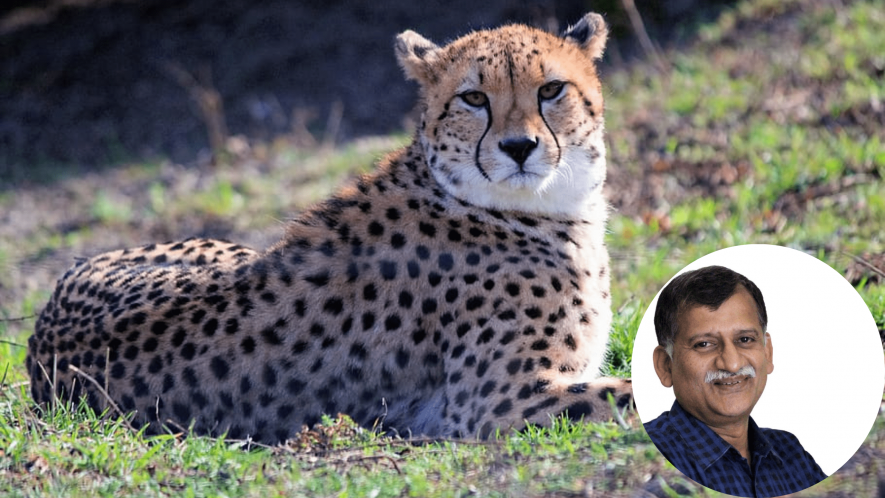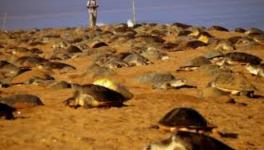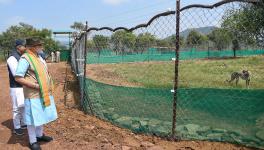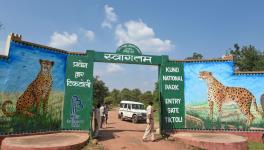India Just Doesn’t Have Habitats African Cheetahs Need: Ravi Chellam

Ravi Chellam, a wildlife conservationist and coordinator of the Biodiversity Collaborative, says India’s scarce conservation resources are being spent on a “costly distraction” of introducing cheetahs from abroad. Six of the 20 cheetahs imported from Namibia and South Africa to the Kuno National Park in Madhya Pradesh have died. Days after the last death of a female from Namibia, he tells independent journalist Rashme Sehgal that India doesn’t seem to have a plan for cheetahs. Whatever ideas exist are confusing and marred by changing priorities and narratives. Edited excerpts from an email interview:
Rashme Sehgal: India’s entire conservation programme seems to have been hijacked by Project Cheetah. Would you agree?
Ravi Chellam: India can ill-afford this costly distraction of conservation attention as well as scarce conservation resources from much higher priority and crucial conservation issues. That too for something not even mentioned in the National Wildlife Action Plan 2017-31.
RS: Nine cheetahs have died in less than 10 months. Is a mortality rate of almost 50% quite normal for such a project?
RC: The project proponents are saying that this is quite normal for such projects. The real question to ask is, should we undertake conservation projects which normalise such high levels of mortality? The reported levels of mortality are much higher than what has been recorded in most of the wild and free-ranging populations of cheetahs in Africa.
RS: Four cheetahs died in captivity. Does this indicate poor management and a lack of preparation?
RC: Until now, we have conclusive explanations for the deaths of only three of the four adult cheetahs that have died in captivity. The reason given for the first female death is that it was due to a pre-existing renal condition. In this case, we need to ask why an animal with a chronic condition was moved to India.
So far, the authorities have not shared any conclusive reasoning for the death of the second cheetah, a male. The third cheetah to die was a female, and it was a result of injuries she suffered when attacked by two males. This was an attempt by the officials to try and get her mated in captivity. The question is, who allowed them to mate in captivity? This could have also been avoided.
The fourth cheetah to die was a male, whose death was due to septicaemia caused by bacterial infections. Open wounds were infested by maggots. Since the cat was in captivity and constantly being monitored, this should have been detected and treated.
RS: Experts have pointed out that some cheetah deaths were due to ticks and maggots. Could these have been attended to at an earlier stage?
RC: Monitoring should have detected the problem, and an earlier intervention could have saved the life of the fourth cheetah, a male who died in captivity.
RS: The National Tiger Conservation Authority and the Ministry of Environment, Forest and Climate Change have informed the Supreme Court that the cheetah deaths are “troubling but not unduly alarming”. What exactly does this mean, and is the NTCA the right organisation to be in charge of the care of cheetahs?
RC: This is a question that NTCA and MoEFCC are best placed to answer. My understanding is that they are using the 50% mortality rate anticipated in the first year, as mentioned in the Action Plan, as the basis for this statement.
RS: A noted South African cheetah conservationist has said that the mortality rate in India’s cheetah introduction programme is lower than in South Africa, which lost 279 cheetahs over 26 years. Many more cheetahs needed to be introduced before the programme picks up, and these deaths are part of “growing pains”.
RC: The African specialists involved with the project have primarily dealt with cheetahs in captivity (fenced reserves)—those are only glorified safari parks. India simply does not have the space to host a free-ranging population of wild cheetahs. Officials in India need to identify, manage and secure at least 4,000 square kilometres or around one million acres of suitable habitat before bringing more African cheetahs to India.
RS: Now, the cheetahs will all be kept in captivity. What are the implications?
RC: The management is taking a precautionary approach to try and ensure all the remaining cheetahs stay healthy. At one level, this may look like a sensible approach. It is important to view this in terms of the stated ultimate objectives of this project, which is to establish a free-ranging population of wild cheetahs. By prolonging the captivity of the cheetahs, the management is definitely compromising the fitness of these cats to be released in the wild.
RS: Does it look like this project has a chance to establish wild, free-ranging cheetahs as originally claimed in the Project Cheetah report, given that the Environment Ministry is doing the contrary now?
RC: Currently, India does not have the required extent of suitable habitats to introduce cheetahs to establish a viable wild population. Without having the required extent of habitats, we have put the cart before the horse by importing 20 cheetahs and then scrambling to find the habitats. How will having 20 cheetahs change our wildlife scenario in tangible terms?
RS: Species like the Great Indian Bustard and the Asiatic lions are crying for attention, but the government claims they do not have the resources for them—does the cheetah project make sense in this context?
RC: The introduction of African cheetahs in India is a distraction from priority conservation issues which include the conservation of highly endangered species and habitats. We should also remember that the introduction of African cheetahs is not even mentioned in the National Wildlife Action Plan.
RS: The Supreme Court has asked the Environment Ministry to find alternative sites in Rajasthan and Madhya Pradesh to relocate cheetahs. What do you make of this?
RC: Currently, India just doesn’t have the required extent of habitats to successfully introduce African cheetahs.
RS: So, is this a skewed programme from the start? What is influencing and shaping our national conservation discourse? Are foreign conservation models being imported without thought?
RC: There is a lot of confusion. Priorities and narratives have been changing. We do run the risk of allowing foreign conservation models to be implemented in India, like fencing our protected areas. Fencing is a very expensive option and it is also unlikely to work in India. This is not the ideal way to be operating. Dr Rajesh Gopal, who currently heads the Expert Committee overseeing the Cheetah Project, has gone on record and clearly said that fenced reserves are not aligned with India’s conservation philosophy and ethos.
The author is an independent journalist. The views are personal.
Get the latest reports & analysis with people's perspective on Protests, movements & deep analytical videos, discussions of the current affairs in your Telegram app. Subscribe to NewsClick's Telegram channel & get Real-Time updates on stories, as they get published on our website.
























